Content Sections
- ● Reality check
- ● Reality check 1: why we lost trust in THEIR science
- ● Reality check 2: The dilution and marginalisation of dissident science
- ● Reality check 3: The term ‘scientific misinformation’ is used arbitrarily
- ● Reality check 4: Real science is a lot less black and white than THEY suggest
- ● AI – the new chess piece on the table
- ● Prebunking
- ● Authority – in which you trust
- ● Epilogue – the happy bit
By Rob Verkerk PhD
Founder, executive & scientific director, ANH-Intl
Scientific director, ANH-USA
Scientific director, ANH Europe
“Those who refuse to consider an unconventional idea in science are disturbingly similar to those who refused to look through Galileo’s telescope”
– AVI LOEB, SCIENTIFIC AMERICAN, MAY 17, 2021
Professor Avi Loeb, world renowned physicist, best-selling author, regular contributor to Scientific American, and Frank B. Baird Jr Professor of Science at Harvard University, didn’t write these words lightly. He knows a thing or two about how scientific breakthroughs occur, and just how challenging it can be to move the needle of the scientific orthodoxy after it settles into a pattern that he likens to religious dogma.
More than that, he’s far from alone. Any half serious scientist understands the importance of dissent and discourse if we're to see genuine scientific progress that benefits people and planet.
Yet we face a time in history wherein the manipulation of both information and people, in order to serve the interests of particular governments and corporations, is unprecedented. While this process is clearly deliberately engineered, the groupthink that has given this process such momentum is less deliberate. Huge numbers of people, from scientists and medics, through to politicians, bureaucrats and the public at large, have become unwitting victims of a very subtle and insidious process that conflates technology with science.
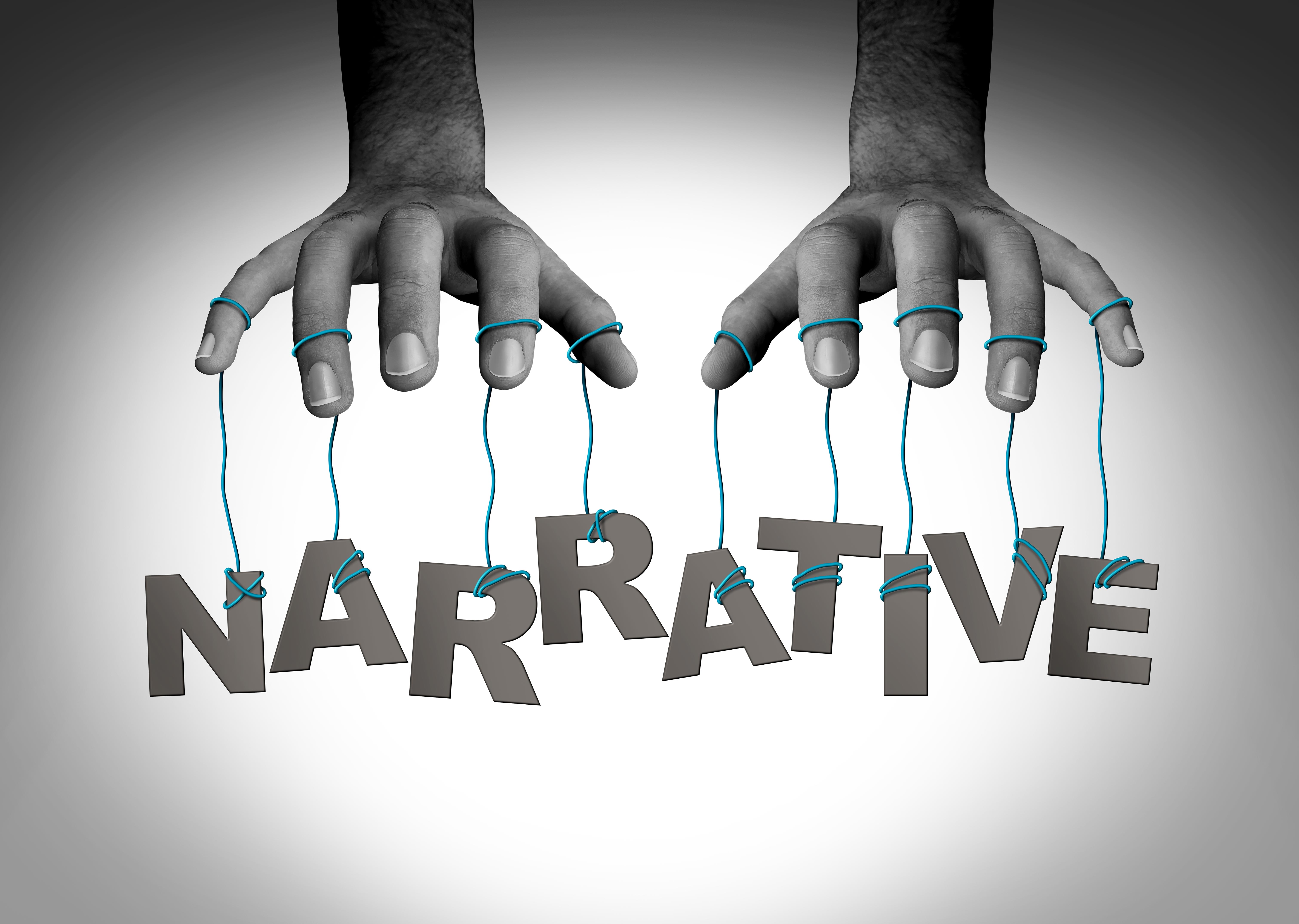
You don’t have to look hard to find examples of this conflation. Back in early 2021, anyone who suggested safety data on C19 genetic vaccines were inadequate and insufficiently transparent was dismissed as being anti-science. Actually, many of us who did just this us are pro-science. We are simply risk aware over a novel technology that we consider was insufficiently tested before being unleashed on the masses. I'm not exactly sure when being cautious became synonymous with being anti-science or a conspiracy theorist? But I think it was around 3 years ago.
Retired neurosurgeon Russell Blaycock – a medic who is now able to stand up and not have to worry about the risk of losing his medical license to practice – opened his editorial in the journal Surgical Neurology International as follows:
“The COVID-19 pandemic is one of the most manipulated infectious disease events in history, characterized by official lies in an unending stream led by government bureaucracies, medical associations, medical boards, the media, and international agencies. We have witnessed a long list of unprecedented intrusions into medical practice, including attacks on medical experts, destruction of medical careers among doctors refusing to participate in killing their patients and a massive regimentation of health care, led by non-qualified individuals with enormous wealth, power and influence".
However, as poignant and accurate as Dr Blaycock’s views may be, they run entirely counter to the narrative of the medico-technological establishment that is in effect a collusion of Big Pharma, Big Biotech, Big Tech, Big Social and Big Media interests.
This multi-headed Hydra is now running the show on what is to be determined as real science or scientific misinformation. This is bad science at its best and it represents a very dangerous chapter in human history. More dangerous, I believe, than any military-based war that has been fought to-date.
With Blaycock’s wise words and gallant warning barely getting a look-in from the corporations that control mainstream information flow, the majority of people are much more likely to come across the following take on science and the public perception of it.
“A survey of over 2000 British adults has found that public trust in science, particularly genetics, increased significantly during the pandemic. However, those with extremely negative attitudes towards science tend to have a high self-belief in their own understanding despite low textbook knowledge.”
So opens an Oxford University piece on trust in science based on a study funded by the Genetics Society carried out by a multi-institutional team of academics in conjunction with the public polling company Kantar Public. The study involved a sample of 2000 Brits, with fieldwork carried out between 1st and 10th June 2021. The findings and its implications were published in PLoS Biology on January 24, 2023. Note that the time period of this study was in the relatively early days of the C19 vaccine roll-out, before a large body of the critical science that is currently available had been published.
This work provides a useful summation of the mainstream scientific establishment’s views on this thorny subject. These views, in turn, feed directly into the machine that is now seriously gathering pace in an attempt to put ever greater numbers of people under the spell of current day scientism.This is the kind of 'science' that aims to fuel the unpredictable and potentially hazardous waters of the AI-infused fourth industrial revolution (4IR).
Based on this, here is a summary of the mainstream view on scientific misinformation:
- Attitude influences position on scientific matters. What people think they know about science is strongly related to their attitude towards it. For example, if they oppose genetically modified foods or covid-19 genetic vaccines, the mainstream view upholds that they are likely to search out and cherry pick facts that support these positions, these facts not being representative of the totality of scientific evidence
- Dissenters are generally bad scientists. Those who oppose ‘well-evidenced science’ are likely to have a poor objective understanding of it (= objective knowledge), and an elevated sense of self-belief and overconfidence about their understanding of it (= subjective knowledge)
- Dissenters have a pumped up sense of their scientific understanding. The mechanisms for overconfidence and high self-belief among those who have poor scientific competence and literacy are not fully understood. But it is proposed that they are associated with two main factors; the first is a fear, distrust or disgust with things they don’t understand; the second is their assumed lesser ability to understand both their own limitations as well as the findings and expertise of leading scientists.
The power and momentum behind this heavily and multi-laterally funded Hydra, that now has its crosshairs focused on building public trust in science, should not be under-estimated. Its globally coordinated rise to prominence also suggests that the scientific establishment is more than slightly troubled by the public’s low level of trust over its activities, despite upbeat pronouncements like the one from Oxford University mentioned above.
An example of the anti-‘misinformation’ machine’s imminent outputs will be the Nobel Prize Summit on Truth, Trust and Hope that will run as a hybrid event in Washington DC between May 24-26, 2023. Among its objectives will be to “Identify how stakeholders work together to develop, adopt, and implement robust solutions for restoring truth, rebuilding trust, and promoting hope”. This is expected to be achieved by consensus among the gathered “Nobel Prize laureates, science experts, policy makers, educators and students”.
Reality check
Hold your horses, I hear you say. Those of us who have countered the mainstream narrative since the World Health Organization’s announcement of the C19 pandemic in March 2020 (check out our reverse chronology of articles on the subject here), will typically tell ourselves that we do have a fairly good grasp of the available science.
We might even think it’s THEY who don’t understand it, that’s why authorities who relied on that science put much of the world into lockdowns, masked them, then exposed them to mass vaccination using novel, genetically-based platforms that had barely been tested on humans. All on the strength of a few, flimsy Big Pharma press releases issued in November 2020 (see Pfizer, Moderna and AstraZeneca releases, respectively). These all made sky high effectiveness claims that were almost unprecedented in the world of vaccine science, as well as reporting no significant safety signals.
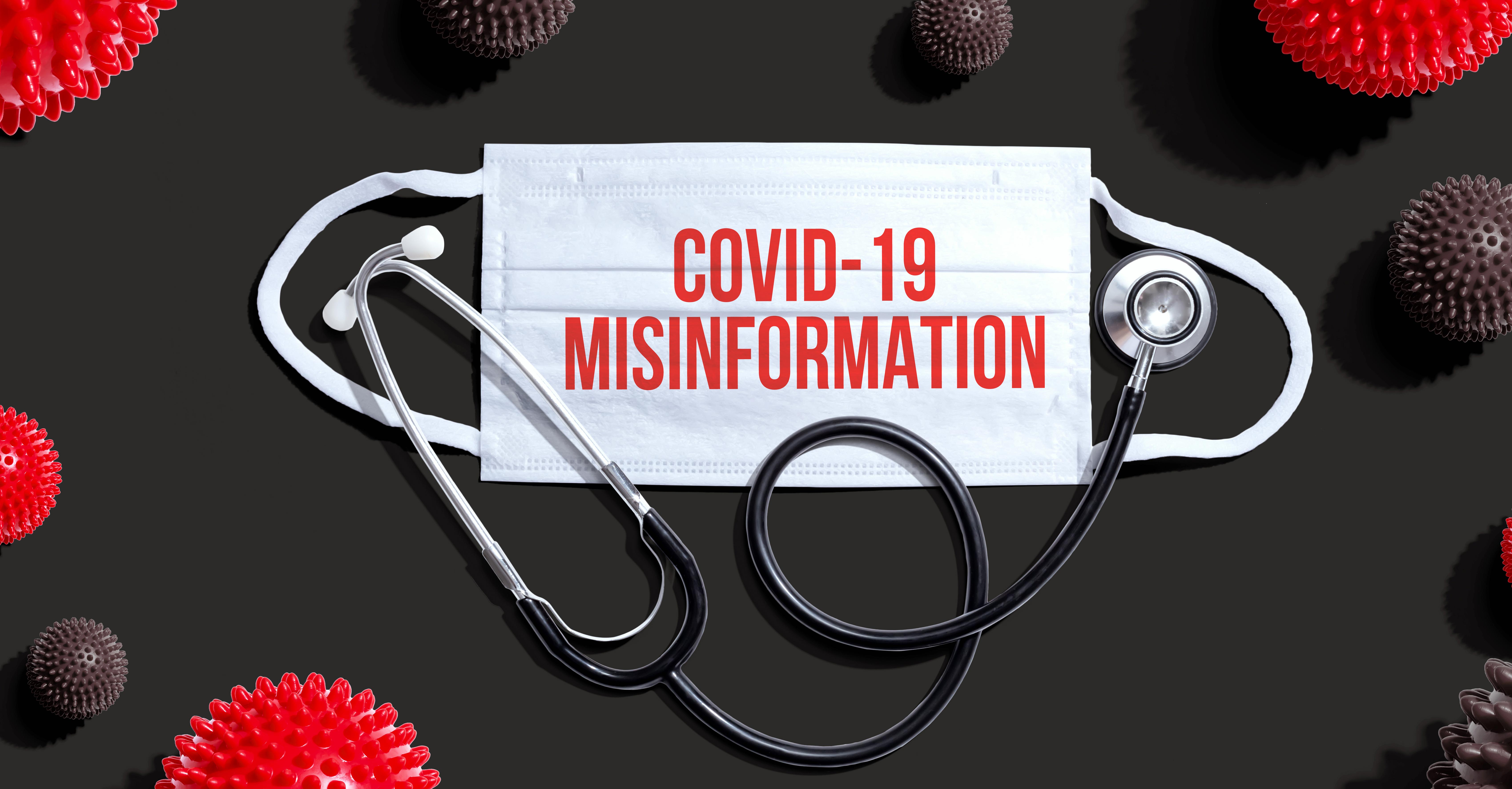
We railed over this at the time – calling out both the poor quality of science, the lack of transparency and the inappropriate communication of findings. But their technological wizardry meant they walked on water and could do no wrong. All of us who dissented were simply low-lifes who didn’t understand the science or the magic of what was about to ensue.
As is always the case, reality is typically a lot more nuanced. As a scientist of some 40 years standing, I argue here that there are four fatal flaws linked to the views of the current scientific orthodoxy:
- Existing scientific views on public trust fail to take into account reasons for the public’s loss of trust in science
- The scientific orthodoxy does not adequately consider the role played by the small number of dissenting scientists and medics who have shaped the scientific view of the counter-narrative, such views typically being incorrectly labelled as medical or scientific misinformation
- Given that scientific or medical ‘misinformation’ has become the catch-all term that identifies what is described as false or misleading information that can lead to public distrust, it is of great concern that the term is often not defined and used arbitrarily to target dissenting voices
- And finally, the orthodoxy tends to ignore the large amount of uncertainty that exists around subjects that might be described by the mainstream as well-evidenced and are often presented as if they were black or white, rather than a multitude of shades of grey.
If we are going to save science, we must allow discourse, and we must allow scientific concepts, judgments and interpretations to be challenged. That means we must not just accept scepticism — we must encourage it, not try to banish it. Good science is the product of human understanding that has successfully withstood the rigours of challenge from those who are sceptical. Banishing dissent is the quickest and surest route to bad science.
If we’re to recover from the current challenge being mounted against dissenting science (mislabelled as ‘scientific misinformation’) in one piece, so that we might be able to use science as a force for human and planetary good, not as a force for corporate gain or political power by the government-industrial complex, we need to understand the above points in some detail.
Let me attempt to break each of them down so that we can be clear about our understanding of them.
Reality check 1: why we lost trust in THEIR science
Let me cut to the chase here. Remember when they told us SARS-CoV-2 was the result of natural spillover and not the result of a lab leak? That lockdowns were absolutely necessary to save lives and prevent burdens on health systems prior to the launch of the genetic vaccines? That masks would protect us from SARS-CoV-2? That life would return to normal once most of us were vaccinated, and that the vaccines were “safe and effective” (a view that is still almost universally proffered by health authorities)?
We all do, of course. Yet scientific research, despite attempts to limit funding or block publication, has slowly but steadily thrown most of these views into disarray. At no time has there been any leading voice from the orthodoxy offering a mea culpa.
Yes, Dr Fauci, you could have made this your apologetic swansong that might have let you sleep better at night as you embark on your new career to inspire young scientists to “follow the science” and take up careers in the public service while avoiding politics. It shows much greater integrity, as well as looking better, to apologise publicly rather than waiting for us to read about your leaked emails in Newsweek. Instead, you chose to retire without any admission of any wrong-doing, that included your routine provision of scientific misinformation to the public!
Following are a few examples of what we were told and what the science currently tells us:
Table 1. Comparing the dissonance between what THEY said and what THE SCIENCE says as a means to better understand public distrust in what is claimed to be “the science”
|
WHAT WE WERE TOLD |
WHAT THE SCIENCE NOW SAYS |
|
|
|
|
LOCKDOWNS |
|
|
Neil Ferguson told UK MPs lockdown would help NHS to “flatten the curve” and manage covid (2020). Modelling study from Neil Ferguson’s group (2020). Modelling study published in Wellcome Open Research (2020). In the USA, the CDC’s “flatten the curve” graphic was widely used by leading scientists to justify lockdowns and social distancing. |
Preprint study finds lockdown effects have been exaggerated (2020). Literature review finds lockdowns had little effect on the spread of covid (2021). Paul Alexander PhD has compiled a list of around 400 studies for the Brownstone Institute website that show that lockdowns cause more harm than good. |
|
COVID-19 GENETIC VACCINES |
|
|
Authorised C19 vaccines are “safe and effective” e.g. CDC (2022), UK NHS (2022), EU EMA (2023) |
The safety claim has been suspect ever since it was found C19 vaccination could lead to cases of potentially fatal vaccine-induced immune thrombotic thrombocytopenia (VITT), splanchic vein thrombosis, post-vaccine myocarditis/pericarditis and Guillain-Barré syndrome. The parameters on which effectiveness claims were based also changed from protecting against transmission at the outset (see Pfizer, Moderna and AstraZeneca press releases), to protecting against hospitalisation, to most recently protecting only against severe disease, while increasing evidence pointed to the poor durability of the vaccines. Covid analyst, Igor Chudov, has recently undertaken a revealing analysis showing the CDC has had a long standing awareness of the limited effectiveness of C19 vaccines, despite them having been the primary plank of the US public health strategy on C19 given the lack of any alternative (hence the suppression of ivermectin, other repurposed generic drugs and nutrients). |
|
C19 vaccine cargo does not enter the systemic (blood) circulation e.g. The EMA states “The uptake of the mRNA in the vaccine occurs mainly in macrophages and dendritic cells of the immune system at the site of injection and draining lymph nodes.“ (2021), CDC the mRNA – “stays in the arm.” (2023). |
Japanese biodistribution study scrutinised by regulatory authorities showed lipid nanoparticle (LNP) encapsulated mRNA was found in key organs and tissues in both rats and humans. Evidence has been mounting linking variations in administration technique, with significant risks resulting from inadvertent vaccine distribution and transfection beyond the muscle site. |
|
C19 vaccine mRNA breaks down within a few days. Horizon, the EU research & Innovation website states, “Once the injected mRNA enters a human cell, it degrades quickly and only stays in the body for a couple of days.” |
Vaccine-derived mRNA sequences have been found to circulate in the bloodstream up to 28 days post injection. |
|
VACCINE VERSUS NATURAL IMMUNITY |
|
|
The CDC, and most other health authorities, have upheld the position, despite emerging evidence to the contrary, that vaccination offers higher protection than previous COVID-19 infection. |
Evidence started building during the first year of vaccination roll-out (2021) that natural immunity confers more robust, broad-based, and durable immunity that protects against moderate to serious disease than C19 vaccination. Paul Alexander has collated 162 research articles on the Brownstone Institute website that point to the superior robustness and/or durability of natural versus vaccine-acquired immunity. |
|
Fact checkers such as Factcheck.org tried to downgrade the importance of a major study from Israel (released in August 2021) that was the largest to compare natural with vaccine-induced immunity because it has not been peer reviewed and was published only on a preprint server. The study found a 13-fold increase in the rate of breakthrough infections among those vaccinated compared with those unvaccinated. |
This study, available as a preprint, emphasises the benefits of natural versus vaccine-induced immunity. The paper had actually been submitted to the influential journal Science but the journal’s decision to withhold publishing it is a reminder of the institutional silencing of dissent. In September 2021, the BMJ posed the question asking why the building evidence on the importance of natural immunity had not lead to US health authorities prioritising this approach, an approach that became ever more rational as the risk/benefit for vaccination became ever less favourable for younger people who are naturally more resilient in the face in C19 infection. |
|
Health authorities continue to advocate use of genetic vaccines along with their latest updates, such as the US CDC and UK NHS. |
A new meta-analysis, part-funded by the Gates Foundation, published in The Lancet, found that natural immunity following covid infection gives ‘substantial’ protection that is at least equivalent to, if not greater than, any protection offered by two covid injections. |
|
MASKS PREVENT TRANSMISSION |
|
|
UK Government advises use of face masks (2020) based on a Lancet published study. The World Health Organization provided a scientific justification for the use of face masks (2020). |
The DANMask trial out of Denmark found masks to be ineffective at preventing transmission (2021). |
|
ORIGIN OF SARS-COV-2 VIRUS |
|
|
Lancet letter (2020) dismisses the lab leak theory. A review of genomic data on SARS-CoV-2 published in Nature Medicine concluded the virus was “not a purposefully manipulated virus” and the authors claimed “we do not believe that any type of laboratory-based scenario is plausible” giving inadequate reasoning |
Multiple Freedom of Information requests over 15 months by Jason Leopold have elicited emails showing the scramble to dismiss the lab leak theory. |
|
PCR TESTS |
|
|
Drosten paper is published on the use of PCR test to detect the SARS-CoV-2 virus (2020). |
The BMJ questions the UK Government’s ‘Operation Moonshot' (2020). Study criticises lack of standardisation of viral load measure. CDC instructions for use state test may not show presence of viable virus capable of infecting others. |
We need to be somewhat philosophical about what we label as scientific or medical misinformation, appreciating that the aforementioned Hydra (the medico-technological establishment) has its own definition that suits its remit perfectly.
The widely used interpretation is an evolution of the term 'misinformation' that was applied to politics prior to its application to science and medicine, coming to public prominence during Donald Trump’s successful 2016 presidential campaign. This era also gave birth to terms like “fake news”. Interestingly, this focus on misinformation, albeit political misinformation, started the process of social polarisation that covid-19 has continued to exploit, with one study showing that Trump opponents regard “fake news as anything they say!” This same kind of unjustified discrimination is now commonly applied to any person who expresses views, or provides evidence, that counters the establishment narrative on covid-19.
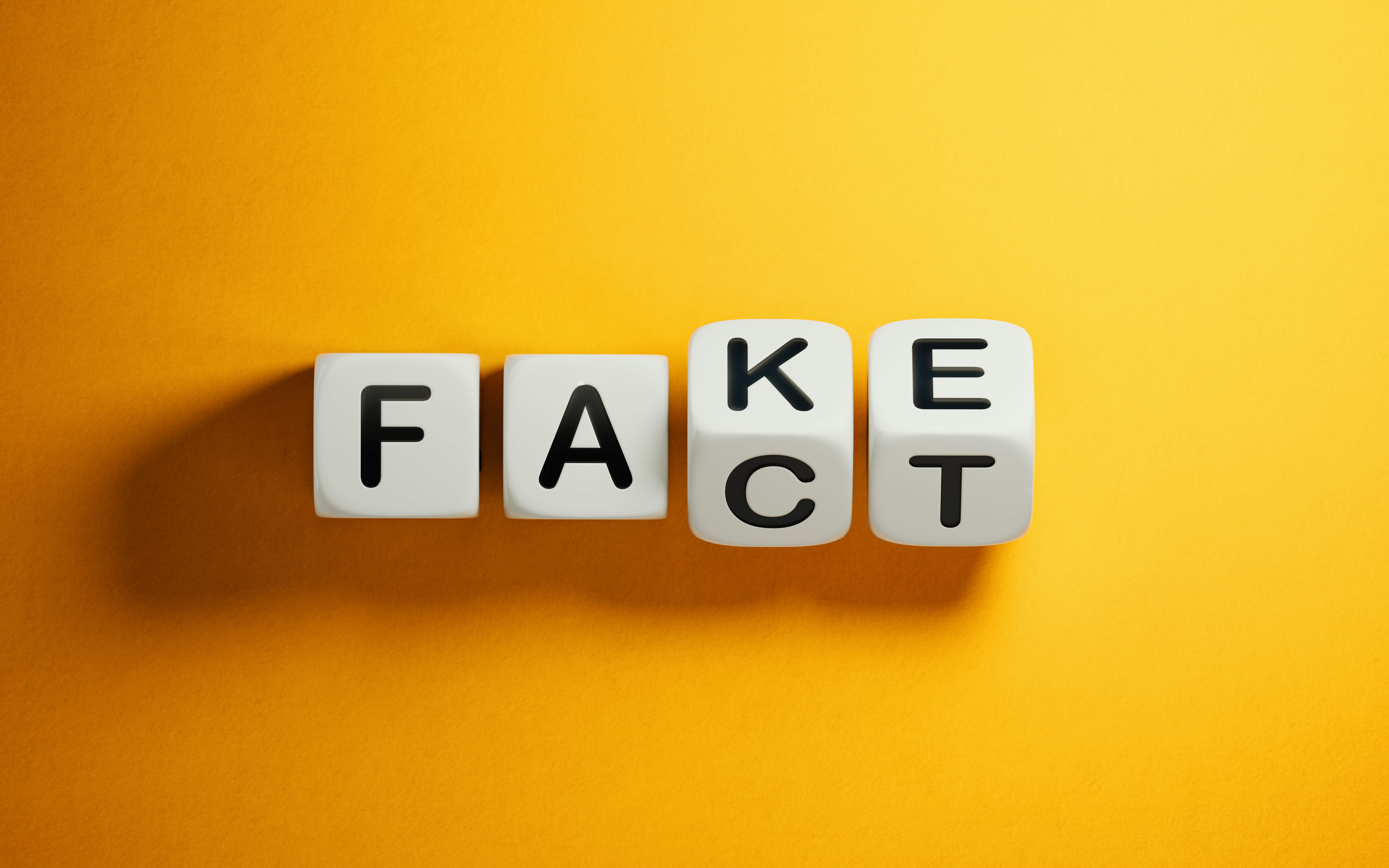
Prominent social scientist, Brian Southwell, from Duke University and the University of North Carolina, along with colleagues, writing in the Annals of the American Academy of Political and Social Science (2022) have attempted to define ‘scientific misinformation’ because they argue “social science literature has lacked consensus to date on the conceptualization, definition, and measurement of misinformation.”
The authors assert, correctly I believe, that science is invariably a collective exercise that attempts to provide approximately true, or at least empirically adequate, descriptions of the world and to avoid those that are false. At the same time the authors also acknowledge that it is important to not get lost in questions over whether absolute truth is knowable to humans.
Southwell et al have emerged with two main limbs to their definition, but they stress that they emphasise that the definition of scientific misinformation should be restricted to "publicly available information that originates outside the process of scientific inquiry”. They argue therefore the root problem with scientific misinformation stems from its being “disconnected from best available evidence and expertise”.
To me, this exclusion of mainstream scientists from the definition is actually a major flaw, because, as we can see in the table above, the mainstream “process of scientific enquiry” can be at least as much a source of misinformation as information emanating from outside it. This of course is largely the result of very well known conflicts of interest that compromise scientific objectivity and integrity.
This flaw may be the result of an understandable oversight by the social scientists involved, perhaps not being sufficiently familiar with the biological, immunological, vaccination and genomic science related to covid-19 to recognise just how distorted the scientific process, and its communication, has become.
Putting aside this flaw, which is the thrust of the second of two limbs of the definition of scientific misinformation put forward by Southwell and colleagues, the first limb is of special interest and one that gives us some useful insights.
The two limbs that Southwell et al (2022) have used to define scientific misinformation are:
1. Scientific misinformation represents claims that fail relevant tests of validity based on the best available evidence or expert judgment at the time, and
2. Scientific misinformation as a phenomenon is a disorder arising from science existing in a public context.
Based even on the first limb of this definition, I would first question who the experts are, then I'd suggest that one of the most common interpretations of covid-19 genetic vaccines as being “safe and effective” (see table above) is a clear example of scientific misinformation.
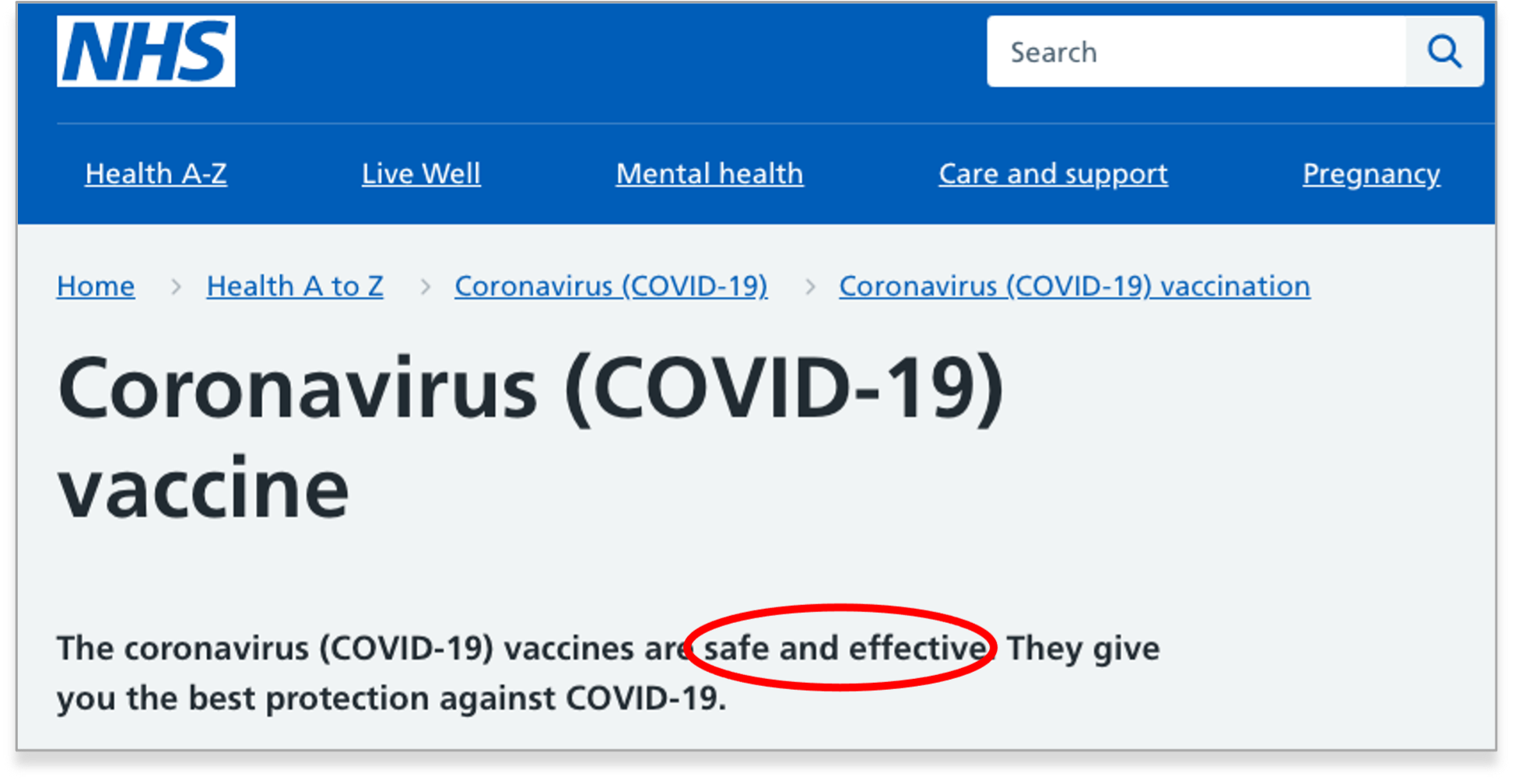
My problem is the Southwell et al second limb. Their flawed second limb actually gets the C19 vaccine experts, presumably Dr Fauci and the rest of them, off the hook! That's assuming the experts are all united. And of course they are, if you've successfully marginalised or discredited any dissenting experts.
The trouble then with the way scientific misinformation is being interpreted is that those most directly involved in the process of scientific enquiry (i.e. the major universities, research and health and institutions) are in effect immune from this label because of their direct involvement with the “process of scientific enquiry”.
Clever, no? And doesn’t it suggest that the public would then have to maintain higher standards of scientific enquiry than ‘chosen’ academics because the public don't benefit from being excused? Instead they (we) are directly in the crosshairs of the ‘annihilate-scientific-misinformation’ machine.
Ponder on this for a moment, then remind yourself that they like people to wonder why we are silly enough, or at least not bright enough, to believe THEIR SCIENCE and TRUST in THEM?
Reality check 2: The dilution and marginalisation of dissident science
Orthodox views as to why people distrust science (as summarised in the 3 bullet points above) often fail to take account of the relatively small sub-population of scientists who are the first to challenge the mainstream scientific narrative and who then help to shape the counter-narrative.
In the context of C19, this includes the likes of eminent doctors and scientists such as Jay Bhattacharya MD PhD, Martin Kulldorff PhD, Peter McCullough MD MPH, Paul Marik MD, Pierre Kory MD and Robert Malone MD.
All were held in high esteem by the scientific and medical establishment, but that all changed after they started to criticise the global response to covid-19. In Kulldorf’s revealing interview with Freddie Sayers from Unherd, the eminent biostatistician and epidemiologist pointed out that he was “attacked by Anthony Fauci and hung out to dry by Harvard”. That’s no way to deal with discourse, unless the intention is to stifle discourse and dissenting expert views which is the only reasonable explanation.
Then they were threatened or attacked from multiple angles, including by their medical boards and sometimes through the courts, while being ex-communicated from mainstream scientific discourse until such time that their views were effectively silenced or discredited in the eyes of the newly appointed arbitrators of science, the mass communication media.
There’s nothing new about trying to marginalise dissent. Galileo and Einstein – rated as among the most important scientists to ever have graced our planet – faced such marginalisation from the scientific orthodoxy at different times during the course of their lives.
Given the upcoming Nobel Trust conference much more recently, three Nobel laureates, Linus Pauling (1954 and 1962), Kary Mullis (1993), and Luc Montagnier (2008).
De Melo-Martín and Intermann, in their 2013 paper in EMBO Reports, wrote,
"The temptation to silence dissenters whose non-mainstream views negatively affect public policies is powerful. However, silencing dissent, no matter how scientifically unsound it might be, can cause the public to mistrust science in general."
Yet, it seems that by fuelling more of the scientists that support – and are supported by –scientific paradigms that take us on the journey into the unchartered water of the 4IR, the scientific orthodoxy will aim to further silence dissent. So ironic when the likes of the Nobel Foundation have such a prominent sprinkling of eminent yet dissident scientists among their laureates.
Reality check 3: The term ‘scientific misinformation’ is used arbitrarily
We have to think of scientific misinformation more as a weapon rather than as a label for badly interpreted science which is at risk of being false. Here’s the main point I’m going to make: We must put the current use of ‘scientific misinformation’ in the same bin as other weaponised terms like “conspiracy theorist”, “anti-vaxxer” and “fake news”. That’s not to say that these latter terms cannot also refer to completely implausible theories around conspiracy, or people who are always opposed to any kind of vaccine out of principle, or those who manufacture information and issue it in order to mislead others (=disinformation). The trouble is that all of these terms are used indiscriminately, with no attempt to examine the underlying argument. They are used to disarm, to distance, to marginalise, to demonise, to disenfranchise, to polarise, to insult, to harm. Yes, they are weapons, and indiscriminate ones at that.
Take one of the predecessors of ‘scientific misinformation’, the current interpretation of the term ‘conspiracy theorist’. History reveals a great chronology of conspiracies that have existed through the ages. Humans – some at least – have an insatiable desire to control others and gain power. A conspiracy can be defined as “An agreement to perform together an illegal, wrongful, or subversive act.”
In recent history, the pharmaceutical industry – including Pfizer – has been found to engage in conspiracies on numerous occasions, as attested to by the criminal cases brought against it and the incredible fines it has had to pay out.
So why is it now so objectionable to be someone who proposes theories over how such conspiracies might arise? Surely some theorising might be just the ticket to help others to jump in and avert the wrongful, subversive or even illegal act before it arises? You can understand why so many accused of being ‘conspiracy theorists’ who have bundles of evidence at their disposal have asked that they be referred to more correctly as ‘conspiracy realists’.
Many blame the CIA for making up the term to sideline people who questioned Oswald’s role in JFK’s assassination. But Ed White’s 2002 paper on the Value of Conspiracy Theory suggests it came into use much earlier to estrange political opponents of Republicanism in 19th century America. The origin of the term is in any event irrelevant when considering its use today. What we can’t afford to deny is that it is now used as a weapon and derogatory term with the specific intent of marginalising or discrediting the person to whom the label has been attached. This is exactly the intended effect of terms like ‘scientific misinformation’ or ‘fake news’ – both of which, it turns out, can also originate from leading scientists, doctors, academic institutions or governments and their agencies.
However, these have all found ways of agreeing that they benefit from immunity from such labels. The result is that those accused of issuing ‘scientific misinformation’ are targeted arbitrarily.
Reality check 4: Real science is a lot less black and white than THEY suggest
I need to make one more important point that we all (scientists and non-scientists alike) need to consider when we appraise scientific information, whether we’re looking at data, interpretations of data, or different hypotheses.
Science – especially emerging science – is very rarely as black and white as often suggested. It is also often very dynamic, being subject to change as new data and research become available. Emerging science often takes us from a hypothesis or a belief, to a place of ‘established knowledge’. It does this through the development of findings and data, that are interrogated by peers and others and determined as plausible, after which they are validated and reinforced over time. This builds consistency and consensus over a period of time, linking theories, plausible mechanisms, experiments and real-world findings through a consistent logic structure.
This concept is crystallised by a ground-breaking paper in the field of network science published by Noah Friedkin and colleagues in the journal Science in 2016. The paper is entitled, ‘Network science on belief system dynamics under logic constraints’. The authors show how individuals in a group can influence each other in order to reach a consensus, as well as how that consensus can change dramatically according to the facts and culture at the time. Friedkin et al showed this in relation to the events that led up to the invasion of Iraq based on what was claimed or thought about weapons of mass destruction.
After reading the paper, I created a slide that was inspired by it, and used in a presentation I gave in 2018 at the Royal Society of Medicine conference that aimed to explore memory in water. I was privileged enough to be speaking alongside two Nobel Laureates, one of which was Luc Montagnier. A copy of the slide is shown below (Fig. 1).
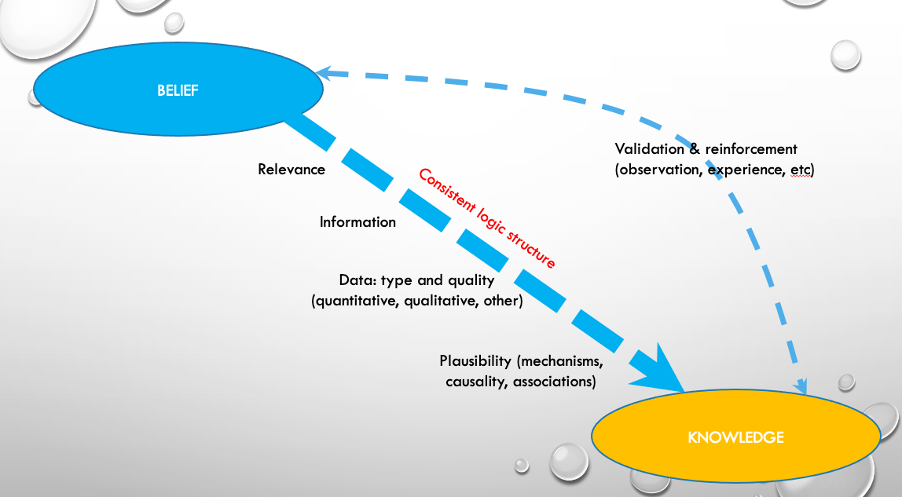
Figure 1. How we turn beliefs into established knowledge through the development of a consistent logic structure. Based on concepts proposed by Friedkin et al (2006).
What you’ll see from it is that if you ditch the opportunity to test plausibility or to validate, you can control your version of what knowledge is. I see this as one of the principal aims of the current witch hunt against scientists who present views that are inconsistent with a narrative, one that may well have been originated by a group of conspirators who have preset their logic structure between people’s beliefs and the agreed knowledge base.
I know I sound like a conspiracy theorist again. But you’ll perhaps understand that when you see things from this perspective it’s not easy to trust in establishment science. I also don’t think I’m alone.
A very quick note on this idea of ‘truth’, that I’m disappointed the Nobel team appear to believe is worthy of targeting in science, hence their use of the term in the title in their upcoming conference. Some like to think that what I’m calling ‘established knowledge’ is in fact ‘truth’. I prefer to think of it simply as objective knowledge which is independent of any individual’s subjectivity at a particular time in our history, viewed from the perspective of a particular culture. I don’t think any of us as humans have the capacity to have insights about absolute truth (and that’s a rabbit hole If there ever was one!). I guess that makes me an alethic relativist. But hey, I’ve also been called a conspiracy theorist, an anti-vaxxer and a scientific misinformation proponent, so it seems I’m on track to collect some more labels!
AI – the new chess piece on the table
I’ve set the scene above for the kind of chess game we’re now engaged in – like it or not. I’ve outlined some of the key chess pieces our opponents are playing with. As with any chess game, it’s only a problem if you take your eyes off your opponent’s pieces. That means we need to be hyper aware, which is why I’d find it difficult to tell you about all of this in a 240 character Twitter post. Disengaging our frontal cortexes is just not an option if we are to preserve and develop ethical societies that value such things as love, connection, and nature (have you noticed the heart in the ANH logo that we put there when I founded the non-profit 20 years ago?).
But there’s another key piece our opponents are getting very good at using. That piece is nothing other than artificial intelligence (AI). Many of you will have used ChatGPT by OpenAI. ChatGPT that has taken the world by storm and is set to be a huge disruptor of both business and culture, has been programmed with establishment information on an incredible array of subjects. Think of it as Wikipedia on steroids.
I asked ChatGPT to tell me why scientific misinformation is dangerous. In a matter of seconds it came up with 4 reasons. In delivering this answer to you, I’ve linked it to an imaginary entity, to give you some sense of its authority, despite the fact it hads no more authority than an AI system and an imaginary institution that sounds credible.
Here goes:
IMPORTANT NOTICE FROM THE HARVARD CENTER FOR TRUTH IN SCIENCE
Scientific misinformation can be dangerous for several reasons:
- It can lead to incorrect decision-making: When people make decisions based on misinformation, they may end up making choices that are not in their best interest or the interest of society as a whole. For example, if someone believes that vaccines are dangerous, they may choose not to get vaccinated, which could lead to the spread of preventable diseases.
- It can harm public health: Misinformation about health and medicine can have serious consequences. For example, if people believe that a certain herb or supplement can cure a disease, they may delay seeking medical treatment, which can be harmful or even deadly.
- It can erode public trust in science and scientific institutions: When people are exposed to misinformation, they may begin to question the validity of scientific research and the credibility of scientists and scientific institutions. This can lead to a lack of trust in important scientific advancements, such as vaccines or climate change research
- It can be used for political gain: Misinformation can be used as a tool to manipulate public opinion and influence political outcomes. For example, politicians or interest groups may spread misinformation about climate change to promote their own agenda, even if it goes against scientific consensus.
In summary, scientific misinformation can be dangerous because it can lead to incorrect decision-making, harm public health, erode public trust in science and scientific institutions, and be used for political gain. It is important to be vigilant in identifying and correcting misinformation and to rely on trusted sources of information, such as peer-reviewed scientific journals and reputable scientific organizations.
ChatGPT’s response (above) will sound incredibly plausible to most people who don’t understand what’s really going on. Note how the answers go straight to two of the focuses ANH has been grappling with over the last three years, namely natural medicines and vaccines in relation to a preventable infectious disease.
It then goes straight into the key topic of this very article, trust in science. AI – it could be said – is on it! But not for our benefit, in this case.
My short-hand interpretation of each of ChatGPT’s answers are:
- This first answer intimates that anyone who questions vaccines might present a risk to the collective by spreading an infectious disease which goes straight to the primary emotion of fear. It also means someone who is vaccine risk aware and so questions C19 genetic vaccines immediately becomes a promulgator of scientific misinformation – as well, by default, an anti-vaxxer
- This answer sets up natural medicines as “harmful” or “deadly” (yes, they’ve pressed that fear button again) and now for the real reason: they might cause people to avoid buying into Big Pharma’s arsenal
- This implies that anyone who questions the scientific establishment’s experts or the authorities has become an unwitting victim of scientific misinformation. It also implies that the great unwashed – those of us who are not (or are no longer) engaged in the mainstream scientific establishment – are the sole disseminators of scientific misinformation. Without even questioning that the establishment seems to do a pretty good job of eroding trust all on its own
- And yes, it all comes down to a power play in the end: who controls who. Imagine if those who didn’t think much of Big Pharma’s boxes of tricks started to gain political power – ooh la la!
Now think how these kinds of ideas and concepts can be replicated, thousands or even millions of times, each being allocated to a unique identity or avatar, some appearing to be credible, in institutions that appear to exist, but actually don’t – like the Harvard Center for Truth in Science.
If you think I’m making this up, think again. In fact, I have it on good authority that all of this is happening already (excepting the new Harvard centre I invented) – so be ready for it.
AI can be used even more subversively. It can deliberately inoculate people with false information – information that comes from seeded ‘experts’, be they real or imaginary, the latter acting as chatbots or deepfakes. It’s already happening in a range of ways, two examples being the catch cry that C19 genetic vaccines are safe (clearly not, here and here) and that natural medicines are dangerous or don’t work (also clearly false).
As people drift towards a world in which they interact with greater and greater amounts of virtual reality – they will care ever less if a real authoritative human is involved. Here’s a frightening thought: they may get to trust the progeny of ChatGPT more than they ever trusted Dr Fauci.
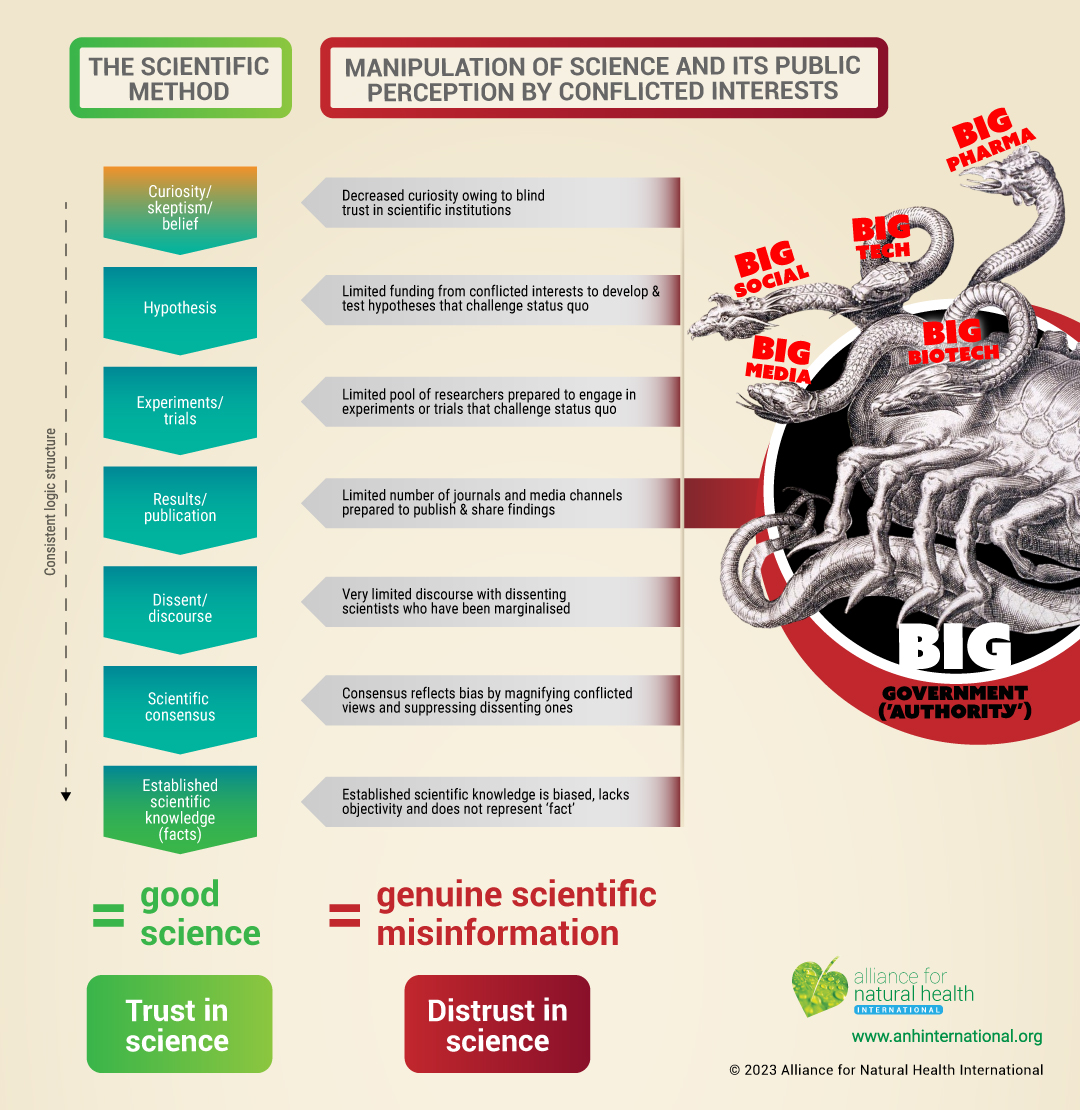
Prebunking
Wrapped up in the gloss of behavioural psychology and new-fangled AI is a new system, being rolled out through social media and internet sites like YouTube, that aims to manipulate those of us who are considered victims of ‘scientific misinformation’. It’s called prebunking. It’s one of the big guns in their armoury that‘s now being wielded to counter ‘scientific misinformation’. It’s the next step on, a big one at that, from attempts to debunk us, that haven’t been working so well of late. That’s partially because of the declining authority of the scientific institutions, associated experts and aligned government agencies. But it’s also because our attempts to use science to debunk them on myths they’ve propagated, such as ‘vaccines are safe’, ‘antivirals work’, ‘lockdowns did more good than harm’, ‘masks for the general public worked’, or ‘natural medicines are dangerous or useless’, have been working quite well.
Prebunking is well beyond proof of concept. They’ve been researching and fine tuning it for several years now, as seen here in this early study by Cambridge and Uppsala researchers published by Harvard Kennedy School.
Prebunking relies on psychological inoculation theory that’s “a framework from social psychology that posits that it is possible to pre-emptively confer psychological resistance against (malicious) persuasion attempts”. Perversely, the model is analogous with vaccination theory. It works by preemptively warning and exposing people to weakened doses of misinformation so that they cultivate “mental antibodies” against fake news.
The science on it has now hit big journals like Science. That’s for a reason: Science is the literary pinnacle of the scientific establishment. They’re that brazen they even like to call ‘scientific misinformation’ “bullshit” which I’ll try not to interpret as being offensive as it’s a great way of adding organic matter to denuded soils.
So get ready to hear more and more information that sounds like 'them' and 'us' are increasingly seeing the world through the same lens. When prebunking is in operation, you (actually not you, but others like you and I who don’t yet see what we see) will barely notice it. They might even feel upbeat because they’ve just seen an ad on social media that shows leading scientists agreeing with 80% of our issues. But it’s the calculated 20% where the difference lies that really counts.
Have you noticed how the mainstream media is becoming alive to myocarditis/pericarditis and blood clots, as ‘rare’ adverse reactions? That social media companies are letting some of this flow across their platforms? Is this THEM waking up to the reality we’ve increasingly been aware of? Or is it prebunking in action. Sadly, it may well be the latter.
Prebunking is definitely no longer experimental. Google has put its front foot publicly forward (yes, the conspirators have emerged from their dens) and will roll out a prebunking initiative across multiple countries in Europe, as well as in America, India and elsewhere. You can read more about it here and here.
Authority – in which you trust
Let me finish this treatise on a seminal point that I mentioned in passing. It’s closely associated with trust, and it’s about the people and institutions we regard as ‘authorities’. Authorities from which we are prepared to receive commands, to ensure our safety in society – this being among our most primal needs.
The trouble for is for the establishment is that if we lose trust in its version of science, we also lose trust in its institutions, experts, politicians and corporations, who espouse the very views to which Chat GPT’s AI is subscribed. That’s a monumental problem if 'we' start to become a significant proportion of the population.
That's why you'll see large groups of establishment organisations coming together, as 50 just have in the USA, in an effort to combat the 'evil' of 'scientific misinformation' - which seems once again, to be more about preserving the status quo at the cost of proper, independent science.
That’s why 'they' are so dedicated to the task of invalidating 'us'. I will conclude now by proposing that scientific misinformation is the next major piece on the chessboard that they will use to do this.
So buckle up and let’s be ready for it.
And now – as I always like a story with a happy ending (although this is more the start of something than an end) – I have some good news.
To survive this assault on those seen to issue their version of ‘scientific misinformation’, we must do what we can to be indifferent to their attacks. We must not waver from our positions, regardless of the weaponry thrown in our direction. We must stand up and engage in discourse whenever we can, in the knowledge that discourse and friendly criticism are essential to scientific progression.
We must build up our own consistent logic structures (Fig. 1). We might even consider that being targeted, rather than weakening us, will embolden us as well as our views, building more confidence in our ability to hold out against what appear to be some very dark forces.
We can also find new authorities, people and institutions other than those in the WHO, the CDC, the MHRA, the EMA, Johns Hopkins, the Gates Foundation and so many more that have sworn themselves to a narrative that does not resonate with the best available scientific evidence in a perennially uncertain world.
Epilogue – the happy bit
There are some signs that we’re winning the chess game – or, perhaps it’s they who are losing. It doesn’t matter too much who’s responsible for the change; let face it, if they’re having a bad game of chess, let’s count ourselves lucky.
This might just be nature or the universe doing it’s bit: righting a wrong, getting science back on track so that it can grow and develop in a climate where it is under challenge. It is the ability of a given scientific perspective or ‘fact’ to successfully survive challenge from all directions that creates robust, objective, knowledge over which there is broad consensus. Not just consensus from among the select few who haven’t been banished by those subscribed to a system that is hellbent on defending the status quo, that has self-determined its right to be beyond reproach.
Here’s another plus that suggests things may be moving in the right direction for those of us who’re interested in the greater good, and the existence of real science: trust in authorities and trust in governments is at an all time low (see here and here).
Pew Research Center’s graphing of public trust in the US government from Eisenhower’s presidency through to the current Biden era brings this problem that is THEIRS not OURS to the fore (Fig. 2).
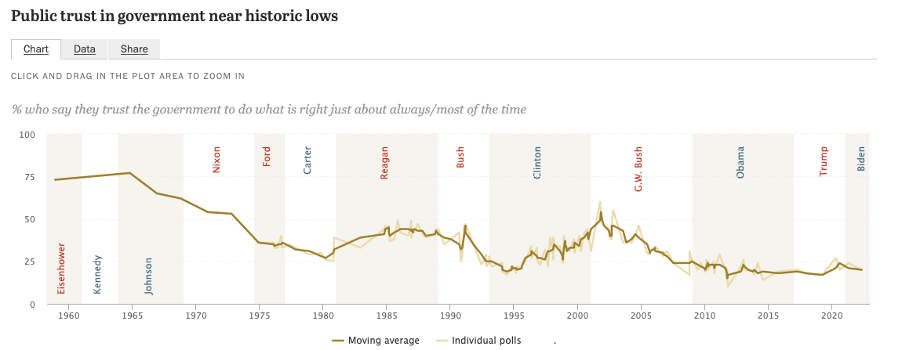
Figure 2. Public trust in the US government from 1958 to 2022. Source: Pew Research Center.
This is another reason why so many of us are so hard at work building parallel structures. Parallel agricultural, health and educational systems. Parallel justice systems. Parallel financial systems. Parallel lives. All built around values that preserve our rights and values, and our intrinsic connection with nature – the things we believe are among the best possible attributes of our species.
I have one hearfelt request: don’t give up your trust in science. It’s a very useful tool when used properly. Forty years on, I’m still a believer.
I shouldn’t have to tell you this (and I’m really not trying to push any fear button here, just a reality button): like any tool, used incorrectly – or put in the hands of untrustworthy operators – it can be dangerous, lethal even.
>>> Visit covidzone.org for our complete curated covid content of the coronavirus crisis
>> Feel free to republish - just follow our Alliance for Natural Health International Re-publishing Guidelines
>>> If you’re not already signed up for our weekly newsletter, sign up for free now using the SUBSCRIBE button at the top of our website – or better still – become a Pathfinder member and enjoy benefits unique to our members.
>>> Return to homepage







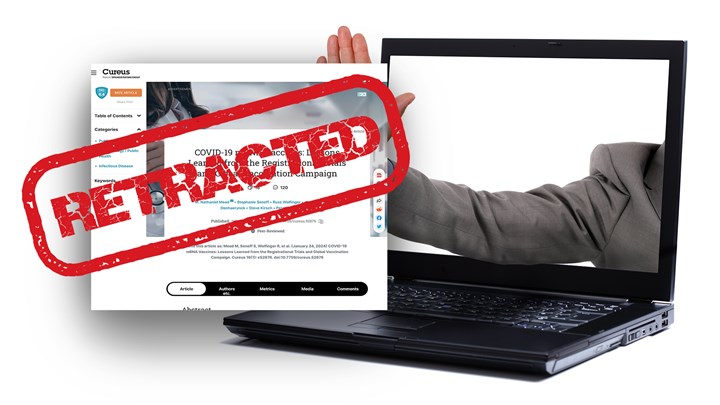
Comments
your voice counts
03 March 2023 at 5:26 pm
I have read this twice - the first time I think I actually almost stopped breathing. The second time, I took on board everything. It is up to us who care to note what is needed and to try and have a sensible conversation with our friends, families about what really is going on. New technology like CHAT GBT is attractive to young people, makes their lives easier in having to think for themselves. The control element of where this information comes from is just not of interest to them. We need to figure out how we can find the right narrative to get them to question things more. I could write endlessly, I just am so grateful to have somewhere to go like ANH to get the whole picture. Thank you for your endless hard work - we are here to support you. Best wishes to all the team.
06 March 2023 at 11:05 am
Many thanks Sue for these very kind and encouraging words. You are so right that so many - young ones included - are being drawn to ChatGPT and other AI services without necessarily appreciating it's part of the transhumanist continuum and that is has the potential to greatly influence public thinking on key issues. I'm concerned about how it might impact human creativity, people's ability to process, reason and rationalise information, let alone how selected information might be used to deliver specific views or 'programs'.
04 March 2023 at 3:31 pm
I was always a problem at school, as I had a terrible habit of always digging below the surface layer of information.
ChatGPT may be called A. I. but all it is doing is scraping information already on the web and using English like syntax to give the appearance of somehow being clever.
Challenging the status quo is a favourite sport of mine, as is playing devil's advocate.
The problem is that if most people don't dig beneath the surface layer of information, they will simply trust in ChatGPT and the current status quo.
The powers that be are doing quite a good job of convincing people, the scary part is that so-called empiricist who are seemingly big thinkers are and have been taken in by those who wield power. I'm thinking of Stephen Fry, who was grateful in 2021 for the faux vaccine.
My suspicion is that school had nothing to do with learning and everything to do with being schooled and to think and believe in a particular narrative.
The end result is that people trust in authority, have a lack of curiosity, and may not have the time to dig below the surface.
It worries me greatly that Google can and does decide on what search results it wishes to show for people searching. Such power and control is the stuff of nightmares.
All the best
06 March 2023 at 11:08 am
Thanks for your comment Steve. My sense is that given so many of us share your concerns, there are not so many parallel efforts to re-create new systems of education, agriculture, healthcare and finance. An ethical alternative to Google would be a fine thing!
18 May 2023 at 1:36 pm
Many thanks Rob for this magnum opus. One element that I think would give useful perspective when thinking about these issues is some expert (historical, sociological) consideration of the ways societies deal/have dealt with flow of information at times of emergency e.g. war, revolution and pandemic, and how these methods are viewed in terms of usefulness and ethics long after the events. I would be most grateful if ANH could find someone capable of giving this perspective.
Your voice counts
We welcome your comments and are very interested in your point of view, but we ask that you keep them relevant to the article, that they be civil and without commercial links. All comments are moderated prior to being published. We reserve the right to edit or not publish comments that we consider abusive or offensive.
There is extra content here from a third party provider. You will be unable to see this content unless you agree to allow Content Cookies. Cookie Preferences